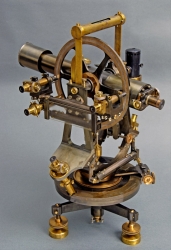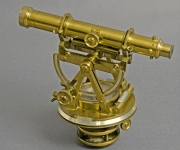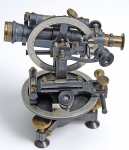Scientific Instrument Society 25th Anniversary Exhibition
Navigation:
<< First | < Previous | Next > | Last >>
03 Three Theodolites
As an ex-RAF-Navigator, then Pilot and Surveyor, I have always been interested in cartography, surveying and the profession of the land.
I concentrated on collecting late 19th-century instruments as, to me, they were constructed in the best traditions of those made from the Renaissance to c. 1820, but benefited from the industrial revolution, the expansion of the machine age, as well as incorporating craftsmanship from the individual tradesman.
Separately were the case-makers, of whom we know little. Many cases were obviously made by furniture or cabinet makers, probably from ‘left-over’ mahogany, walnut or oak and are masterpieces of design and economy of space.
Collection: Jeremy Collins, Oxfordshire
A theodolite is used in surveying to measure horizontal angles (azimuth) and vertical angles (altitude).
The small lacquered, brass instrument, signed ‘Troughton & Simms, London’ was made about 1830 and similar designs were produced by all the instrument makers of the period.
Although the larger instrument has the same signature, it is considerably later. By repute it is said to have been used during the construction of the 12 mile long Simplon Tunnel, Switzerland (1898-1906), however a second parallel tunnel was opened in 1922. It is a very high precision instrument, the azimuth circle being totally enclosed, and both azimuth and altitude circles are read by micrometer microscopes. A lamp is used to illuminate the eyepiece micrometer.
When the noted instrument maker Edward Troughton (1756-1835) retired in 1826, he took into partnership William Simms (1793-1860), the firm becoming a limited company in 1915.
The black lacquered Austrian theodolite is signed ‘7135 NEUHÖFER & SOHN, WIEN’ and was made about 1900. It too has scales read by microscopes, but its small size would give far less precision. There is a slide rule by the same maker in the slide rule case near the front entrance to the Museum.
P.D.



